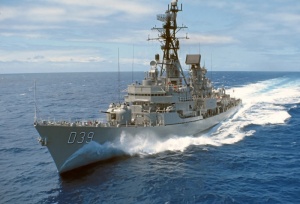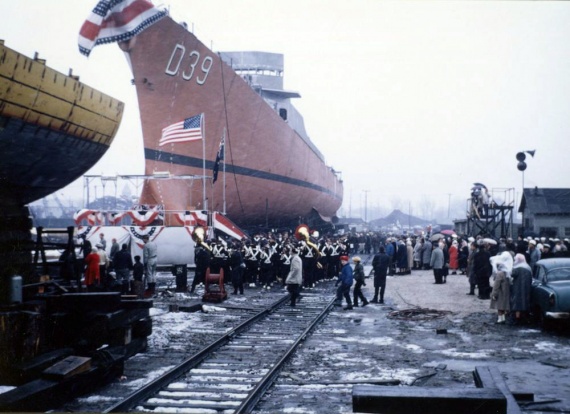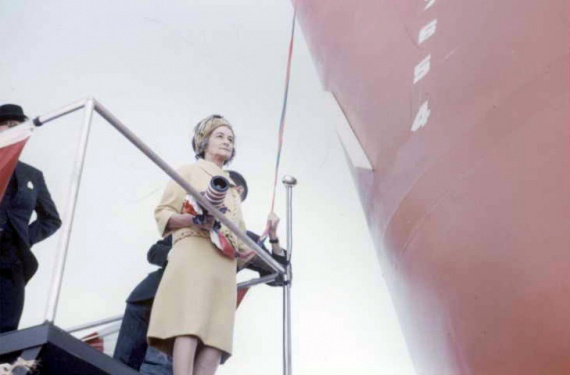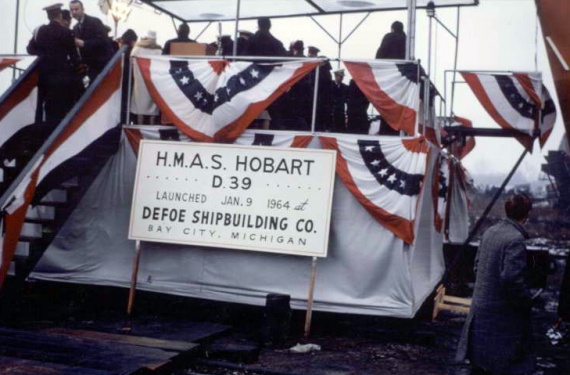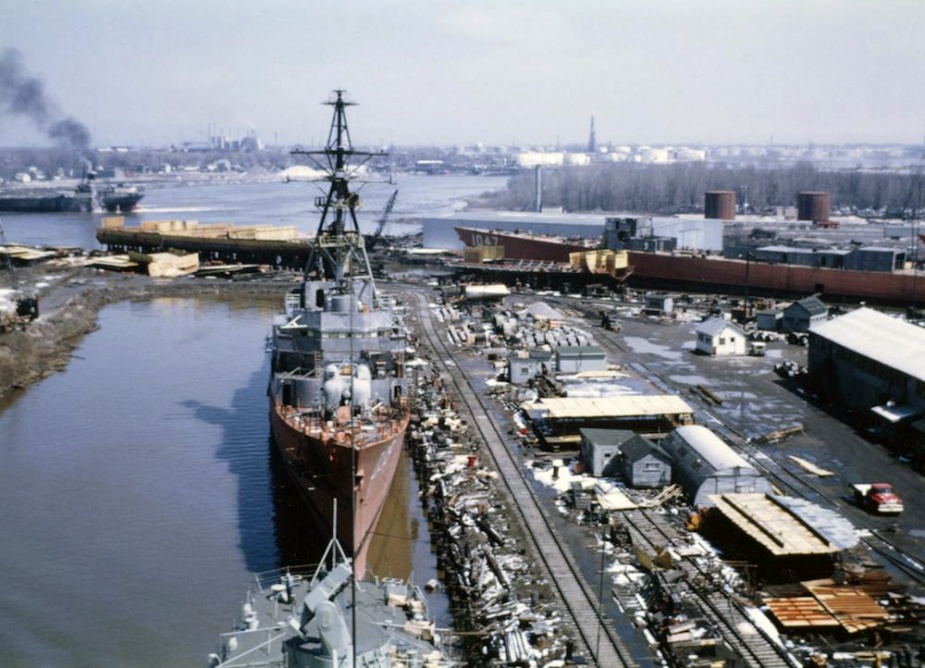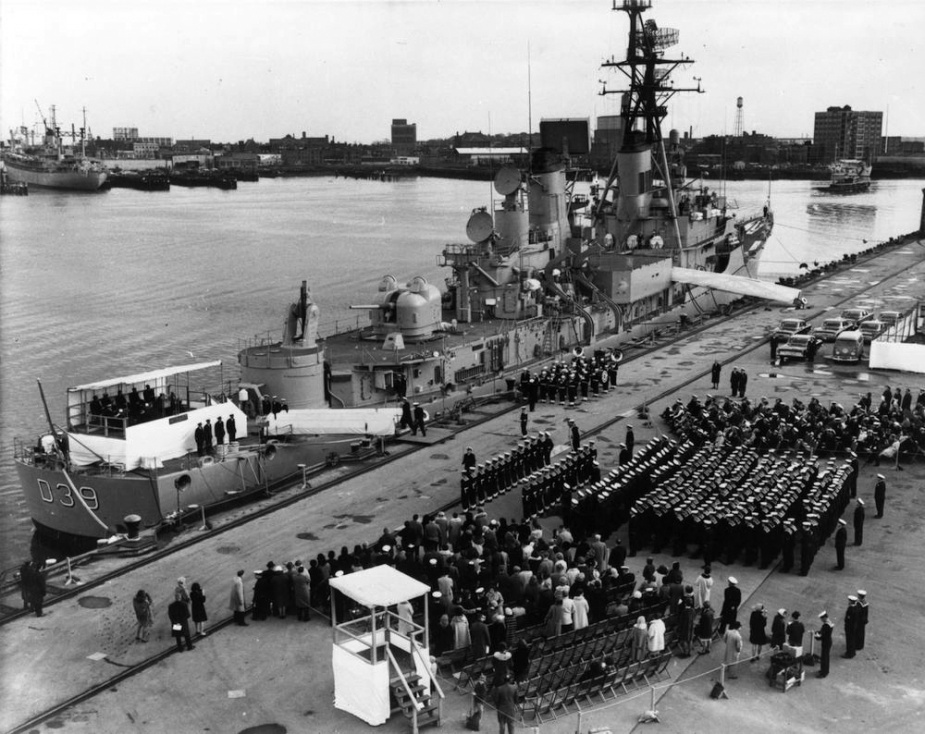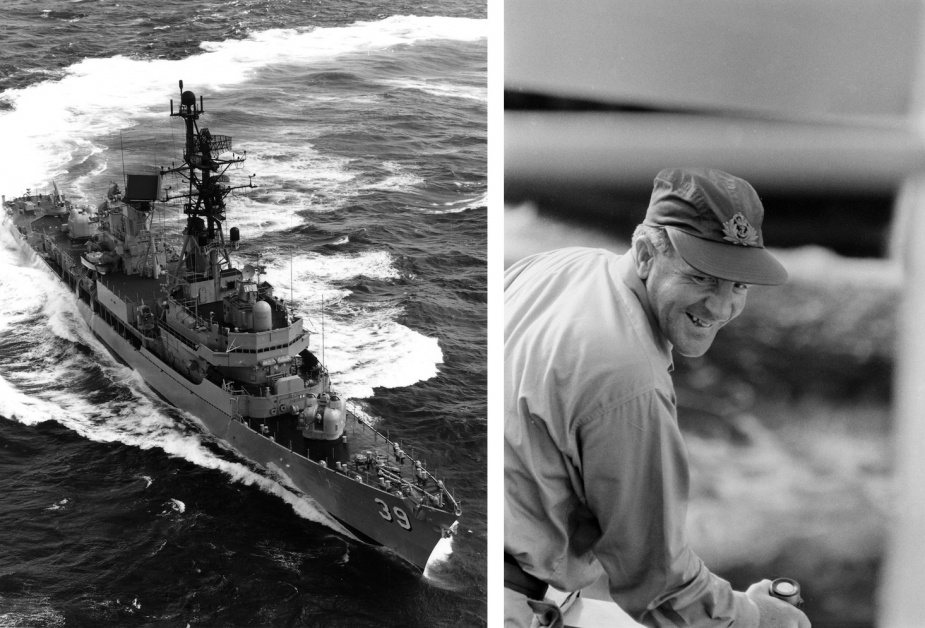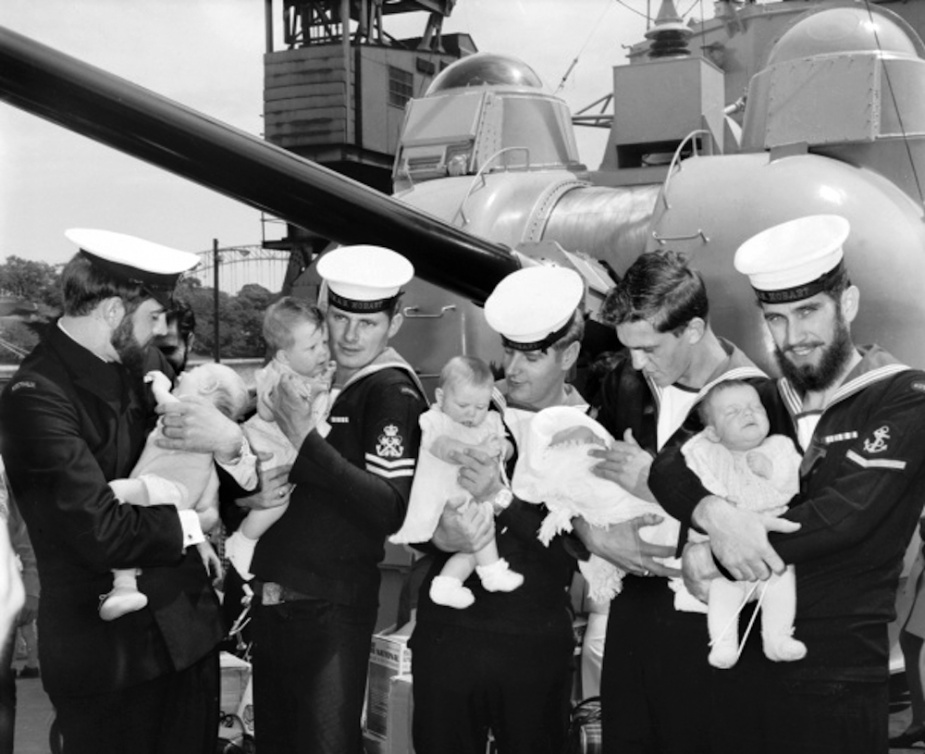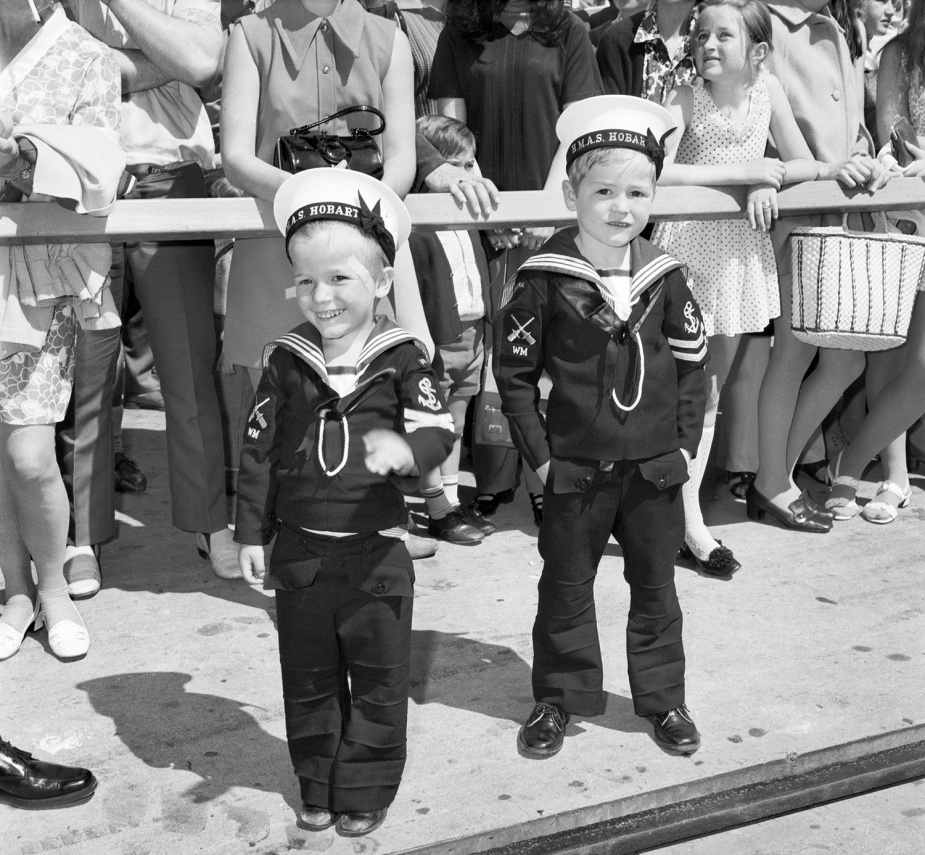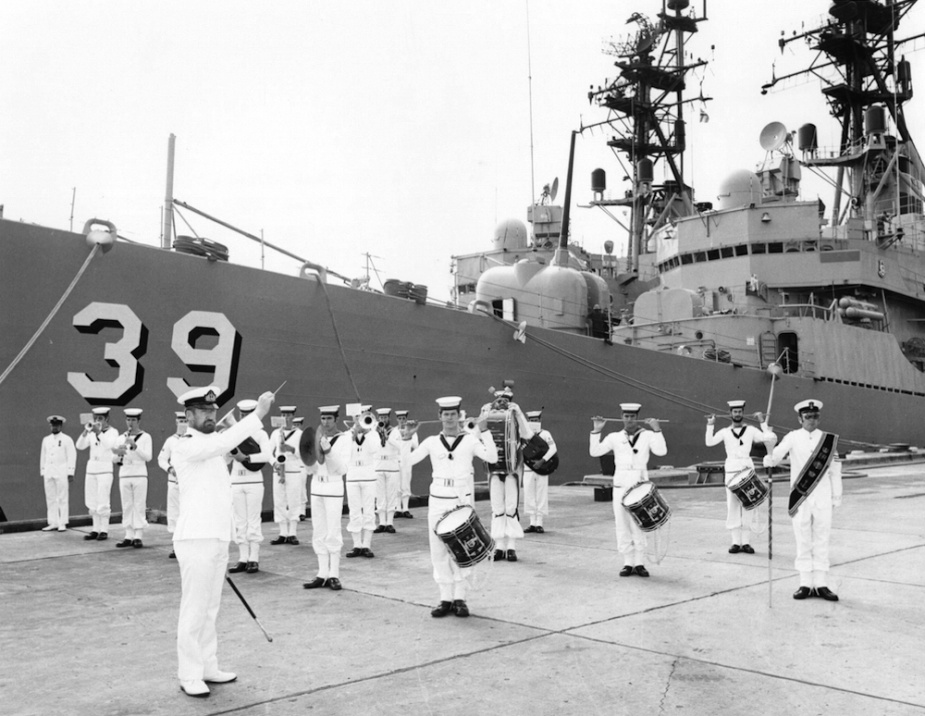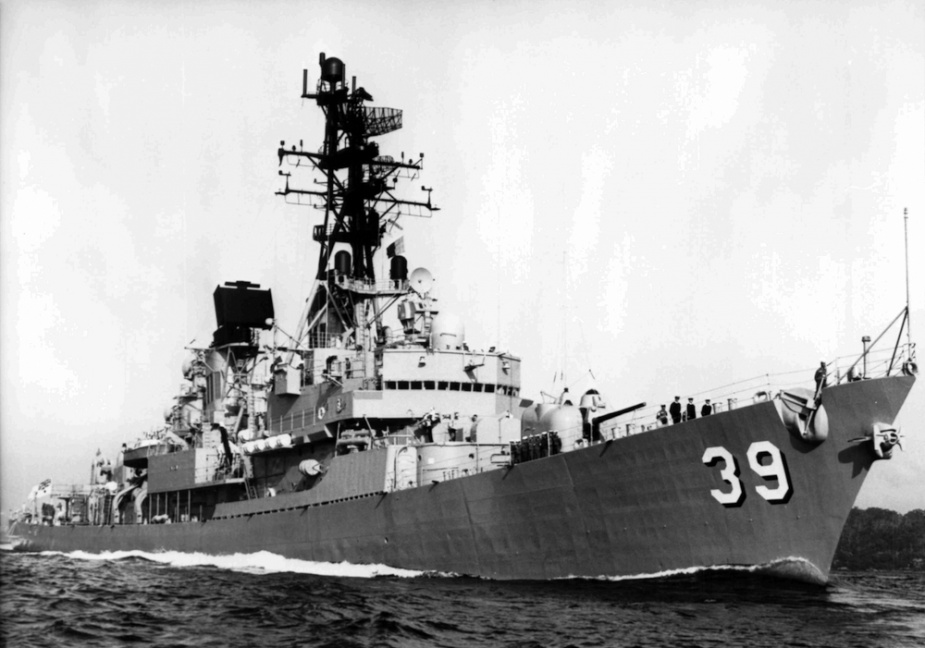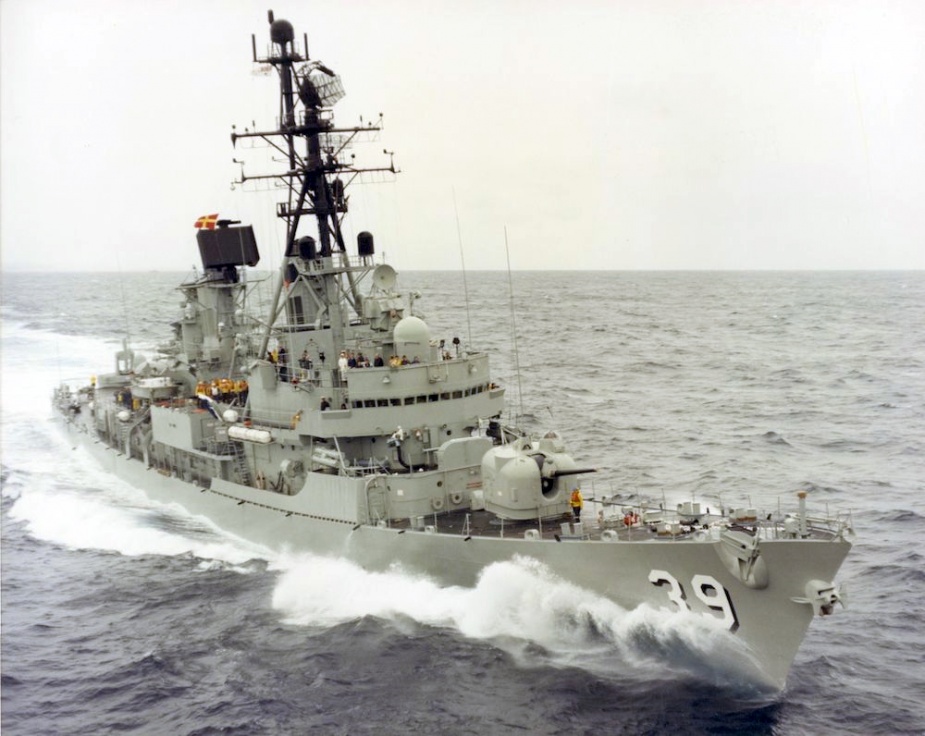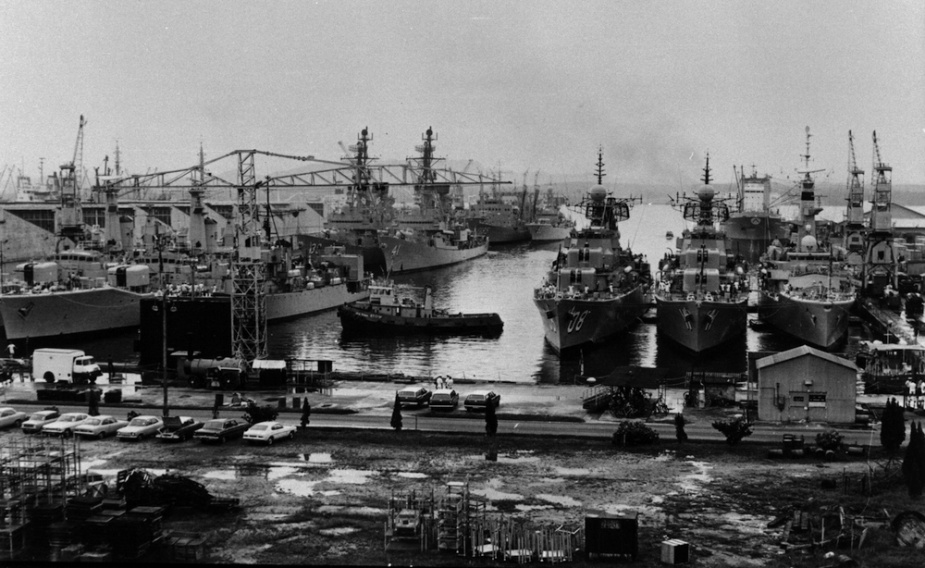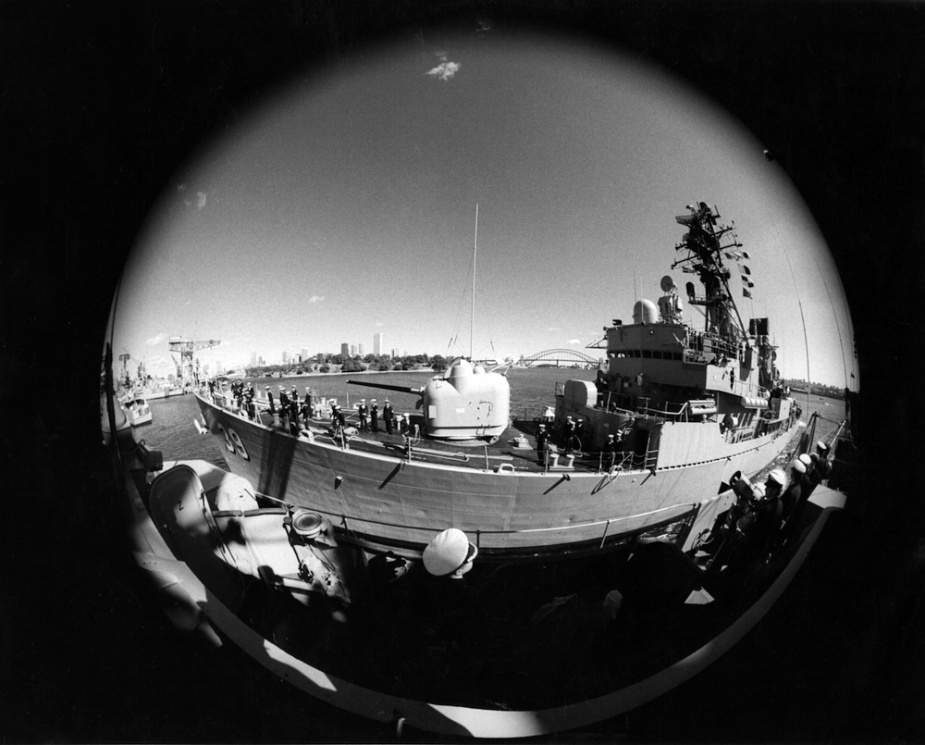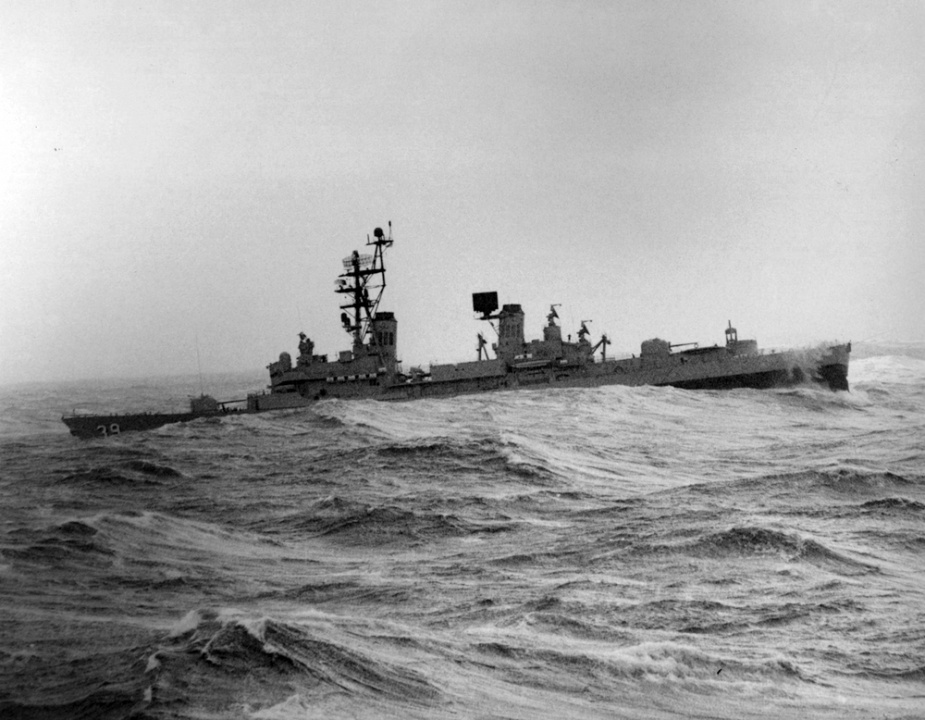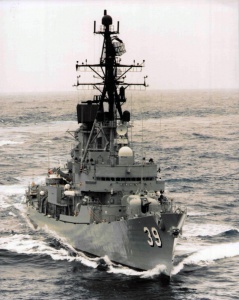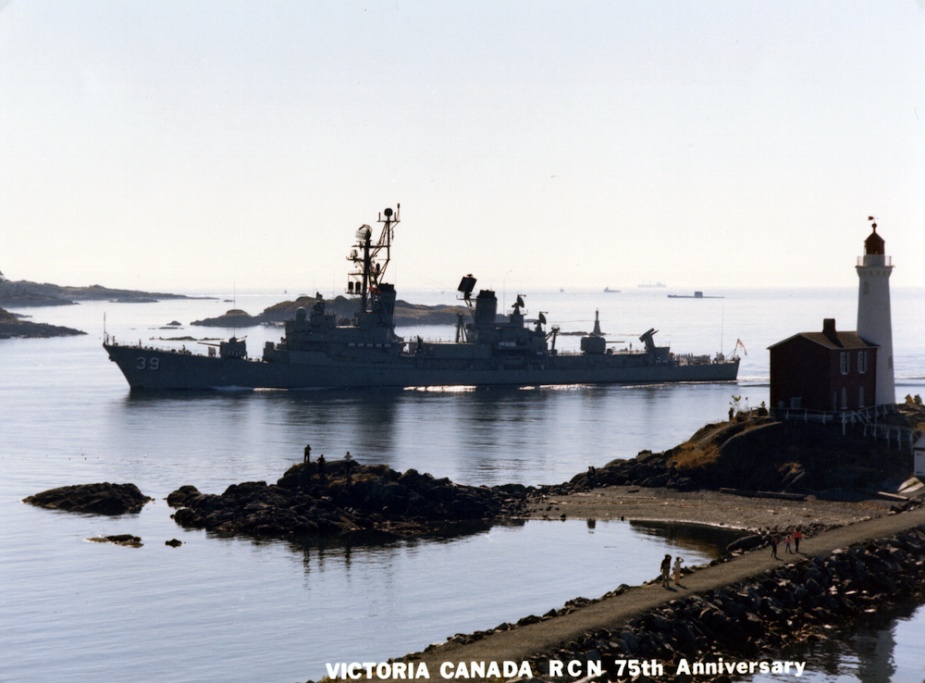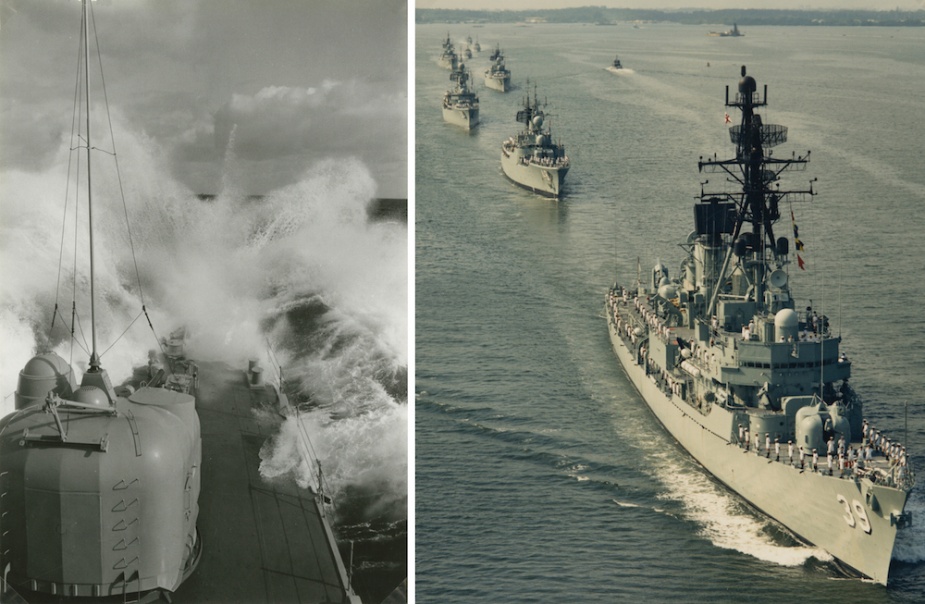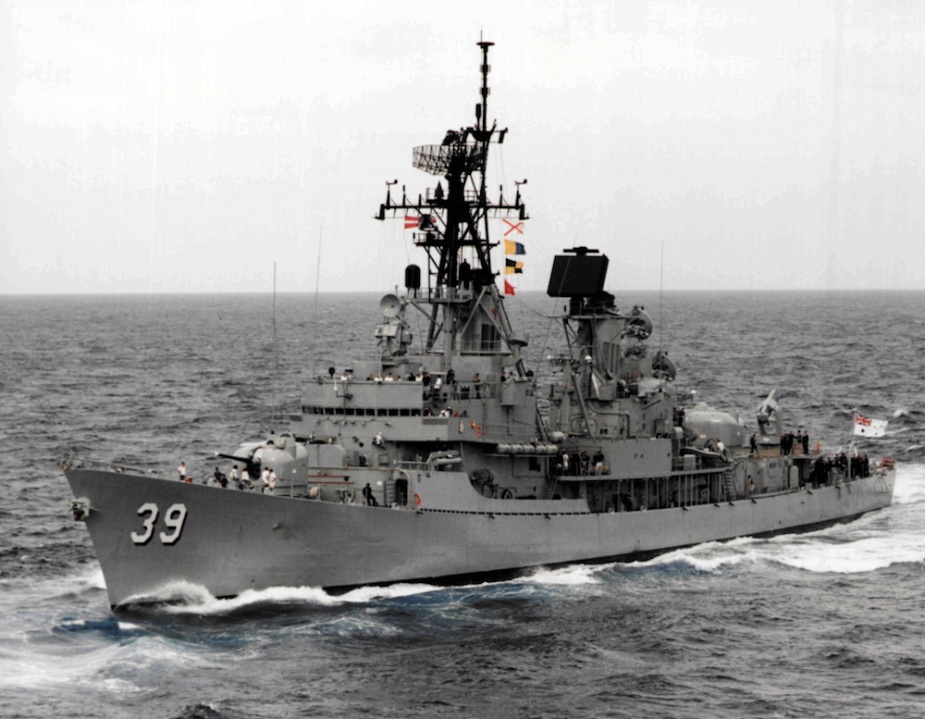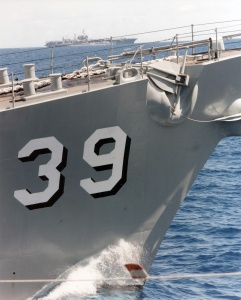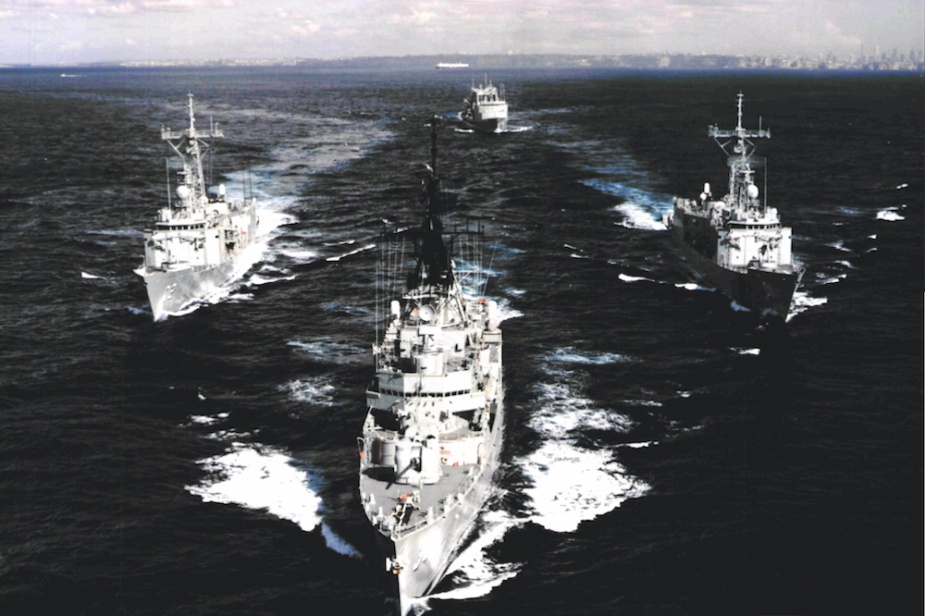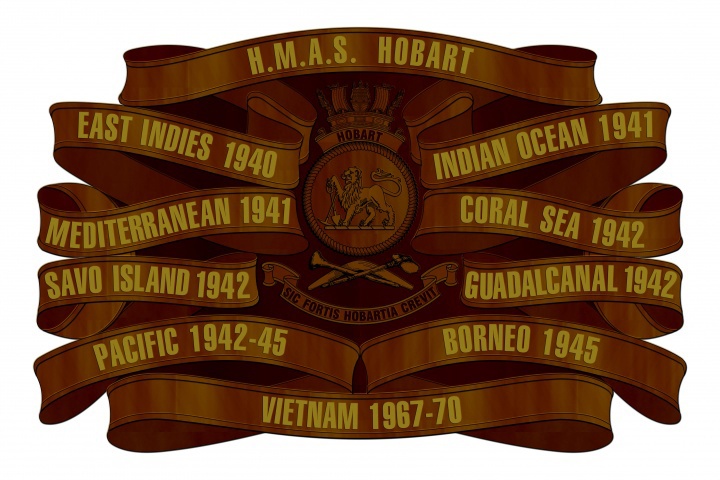HMAS Hobart (II)
| Class |
Charles F Adams Class |
|---|---|
| Type |
Guided Missile Destroyer |
| Pennant |
D39 |
| International Callsign |
VKLB |
| Nickname |
Green Ghost |
| Motto |
‘Thus in Strength Did Hobart Grow’ from the Latin ‘Sic Fortis Hobartia Crevit’ |
| Builder |
Defoe Shipbuilding Co, Bay City, Michigan, USA |
| Laid Down |
26 October 1962 |
| Launched |
9 January 1964 |
| Launched by |
Mrs DO Hay, wife of the Australian Ambassador to the United Nations |
| Commissioned |
18 December 1965 |
| Decommissioned |
12 May 2000 |
| Dimensions & Displacement | |
| Displacement | 4500 tons (full load) |
| Length | 440.8 feet (overall) |
| Beam | 47.1 feet |
| Draught | 20.1 feet |
| Performance | |
| Speed | 35 knots |
| Complement | |
| Crew | 333 |
| Propulsion | |
| Machinery |
|
| Horsepower | 70,000 |
| Armament | |
| Missiles |
|
| Guns | 2 x 5-inch (54 calibre/127mm) single mount rapid fire guns |
| Torpedoes | 2 x 324mm Mk 32 anti-submarine torpedoes (later) |
| Awards | |
| Inherited Battle Honours | |
| Battle Honours | VIETNAM 1967-70 |
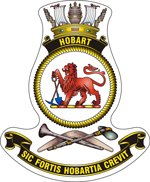
HMAS Hobart (II) was one of three improved Charles F Adams Class guided missile destroyers (DDG) built in the United States for the RAN. The destroyers were referred to in the RAN as Perth Class DDGs and their primary role was air defence. Hobart was the second ship of the class and was constructed by the Defoe Shipbuilding Company, Bay City, Michigan, USA. She was launched on 9 January 1964 by Mrs DO Hay, wife of the then Australian Ambassador to the United Nations.
On 18 December 1965 Hobart commissioned under the command of Captain GR Griffiths, DSC, RAN at the Boston Navy Yard.
Following commissioning Hobart undertook a series of sea trials and exercises, before sailing to Norfolk, USA, in January 1966. Exercises in the Norfolk area were followed by her departure for Mayport, Florida in February and participation in further exercises in US waters. Hobart then proceeded via the Panama Canal to Long Beach, California, arriving on 13 March. After exercises in the Long Beach and San Diego areas, she proceeded to Bangor, Washington. While based there, she exercised in the Puget Sound and Ediz Hook areas before sailing for Vancouver, Canada, on 21 April. Following a successful four day visit Hobart sailed for San Francisco and San Diego where she continued to work-up before completing final acceptance trials between 16-18 May. She then returned via San Francisco to Long Beach Naval Shipyard, where she remained for most of June. In July the ship completed Post Shakedown Availability.
On 3 August, Hobart began the first leg of her voyage to Australia calling at Pearl Harbor, Hawaii and Suva before arriving in her namesake city, Hobart, Tasmania, on 1 September 1966. She berthed in her home port of Sydney for the first time on 7 September 1966. In October she took part in Exercise SWORDHILT.
Service in Vietnam
HMAS Hobart (II) undertook three deployments to Vietnam:
|
Deployment
|
Commanding Officer
|
NGS Callsign
|
| 07 Mar 1967 - 27 Sep 1967 | Captain GR Griffiths, DSC, RAN | Royal Purple |
| 22 Mar 1968 - 11 Oct 1968 | Captain KW Shands, RAN | Royal Purple |
| 16 Mar 1970 - 17 Oct 1970 | Captain RC Swan, RAN | Pacific Ocean |
During these deployments, Hobart served as part of the US Seventh Fleet, participating in Operation SEA DRAGON and serving on the gunline providing naval gunfire support (NGFS) and harassment and interdiction (H & I) fire. Targets included Viet Cong troop concentrations, military bases, bridges, caves, storage areas, weapons positions, supply routes, wells, trucks, ammunition dumps, sampans, dams, bunkers, wharves, boat yards and arms caches. She also provided support to US Marine and airborne divisions, the Army of the Republic of Vietnam as well as undertaking plane guard and escort duties with US aircraft carrier striking groups.
At times Hobart came under heavy fire from the shore, but escaped damage. Hobart’s contribution received high praise from senior US naval officers. A typical signal, received on 23 April 1967, read:
DEPARTURE OF DRAGON FROM DOWN UNDER VIEWED WITH REGRET AND SENSE OF LOSS OF LONG RIGHT ARM. HOBART’S AGGRESSIVENESS AND SUPERB PERFORMANCE UNDER FAST MOVING, HOT COMBAT CONDITIONS LEFT NOTHING TO BE DESIRED. PROUD TO HAVE YOU ON THIS TEAM AND EAGERLY LOOK FORWARD TO JOINING YOU IN FUTURE SHOOT OUTS WITH THE ENEMY.
Among the many notable incidents in which Hobart was involved was the occasion when she went to the assistance of USS Forrestal on 29 July 1967 after the aircraft carrier suffered a major fire which caused numerous casualties. Hobart provided firefighting equipment and transferred Surgeon Lieutenant L Barnett, RAN to the carrier to help with the care of the injured.
Hobart returned to Sydney on 27 September 1967 having steamed 52,529 miles. She had expended 9204 rounds of 5-inch ammunition and had come under enemy fire on nine separate occasions. Later that year Hobart was awarded the coveted Duke of Gloucester’s Cup for being assessed as the most efficient unit of the RAN fleet. She was to win this cup on seven further occasions (1970, 1975, 1979, 1982, 1988, 1992 and 1994).
In recognition of the professionalism of her crew during her first deployment to Vietnam she was awarded a US Navy Unit Commendation for ‘exceptionally meritorious service’ as an element of the US Seventh Fleet during the period 10 March to 20 September 1967. The award was presented to Captain Griffiths on 21 April 1969. The citation highlighted the “outstanding teamwork, courage and professionalism displayed by Hobart’s officers and men.”
Hobart deployed from Sydney for her second tour of duty in Vietnam on 22 March 1968 under the command of Captain KW Shands, RAN. An unusual feature of this deployment included a visit in May to Kaohsiung, Taiwan. In Vietnamese waters Hobart undertook a broad range of duties including providing naval gunfire support to Allied forces ashore and participating in the interdiction of enemy water borne logistic craft (WBLC).
On 17 June 1968, Hobart was in the vicinity of Tiger Island when when she detected an aircraft approaching her from the vicinity of Cap Lay. Although the aircraft was evaluated as friendly it continued to close and fired a missile that struck Hobart amidships on her starboard side. The warhead passed through the main deck, seriously damaging several compartments, while the body of the missile passed through the outer skin of the after funnel before ending up in the forward funnel. In its passage the missile killed Ordinary Seaman Raymond John Butterworth and wounded Able Seaman JR Parker and Ordinary Seaman RF Davidson.
As Hobart’s crew raced to action stations a second and third missile hit the ship. The second missile entered the transom without detonating, destroying the gunner’s store before breaking up in the engineer's workshop and penetrating the after seaman’s mess. The third missile hit the ship in the same area as the first, passing through one of the ship’s fan spaces, the missile director equipment room and Tartar checkout room. Chief Electrician Raymond Henry Hunt was killed in this attack and several sailors injured. The aircraft was seen to pass over the ship before turning again for what appeared to be a further attack run. At 8000 yards the crew of Hobart’s forward gun engaged the aggressor, firing five rounds in local control, causing it to turn away before being lost to radar south of Tiger Island. As Hobart’s damage control parties made their assessment USS Edson, which was operating in company with Hobart, reported that she too was coming under fire from air launched missiles. The force consequently cleared the area to the west with Hobart departing the operational area to effect repairs in Subic Bay, Philippines. En route the ship’s company begain clearing away debris, finding and collecting pieces of the missiles which were later identified as being of US origin. It transpired that Hobart was one of several ships mistakenly attacked by US 7th Air Force jets on the nights of 16-17 June. Hobart subsequently arrived in Subic Bay on 19 June where her damaged was assessed. The destroyer had suffered serious damage to her weapons systems, electrical systems and hull. The Ikara missile magazine had also suffered heavy damage in the attack and it proved fortunate that it was empty at the time of the attack. On 25 July Hobart returned to Vietnamese waters where she resumed operations southeast of Da Nang.
From November 1968 until July 1969 Hobart underwent a major refit which included the fitting of the Australian designed Ikara anti-submarine missile system and launchers.
On 16 March 1970, under the command of Captain RC Swan, RAN, Hobart deployed on what was to be her final deployment to Vietnam. She relieved HMAS Vendetta in Subic Bay on 28 March and following the usual phase of handover briefings and exercises took up station on the gunline in southern II Corps on 6 April. Between April and September Hobart undertook numerous fire support missions firing some 16,557 rounds of 5-inch ammunition. She returned to Sydney on 17 October having steamed 40,344 miles.
In February 1971, Hobart undertook a training cruise to New Zealand, calling at the Bay of Islands and Auckland. A workup period in June and July was followed in August by the Prime Minister’s announcement that the ship would not relieve HMAS Brisbane in Vietnam. This was a great disappointment to the ship’s company. In October Hobart departed for Pearl Harbor, to participate in ASWX and RIMPAC 71. She returned to Sydney on 10 December.
On 27 January 1972 Hobart departed for Manus Island and then proceeded to Subic Bay, before participating in Exercise SEAHAWK. She then took passage to Manila, Hong Kong and Singapore before taking part in Exercise GENESIS. After returning to Singapore, she proceeded via Christmas Island, Fremantle and Melbourne, before returning to Sydney on 14 April.
In June she sailed via Suva and Pearl Harbor to San Francisco. She remained there at Hunters Point Naval Shipyard until November to allow her gun mounts to be updated. She then returned to Sydney, via Los Angeles, Pearl Harbor and Suva, arriving on 18 December.
In 1973 visits to Devonport, Fremantle and Wellington, New Zealand, were followed by a refit lasting from May until December.
In June 1974 Hobart departed for the Coral Sea where, with British, United States, New Zealand and other Australian ships, she participated in Exercise KANGAROO ONE and in Exercise BOOMERANG ONE. In August she commenced the CASEX phase of JUC 93, followed by the LONGEX phase. Further exercises followed with visits to Port Phillip Bay, Devonport, Hobart and New Zealand (where Hobart spent time in the Milford Sound, Nelson, Auckland and the Bay of Islands). MAREX 74 was completed in November, as was Exercise TASMAN TRICKS.
On Christmas Day, news of Cyclone Tracy was received and recall of the ship’s company began. Further build-up of the crew occurred on 26 December and stores were loaded. On 27 December Hobart cast off and left in company with HMAS Supply and HMAS Vendetta (II). On 30 December the ships briefly berthed in Townsville before sailing for Darwin later that day.
On 3 January 1975 Hobart, in company with Supply and Vendetta entered Darwin Harbour and the first working parties were landed. Members of the ship’s company undertook clearing and rehabilitation tasks in support of Operation NAVY HELP DARWIN. The ship quickly settled into a routine: over 100 men were landed daily and they worked two days ashore and had one day on board. Work ceased on 16 January and two days later Hobart departed, entering Sydney on 24 January. On 18 February she left for Hawaii, in company with HMAS Melbourne (II) and HMAS Parramatta (III). Hobart arrived in Pearl Harbor on 3 March. A week later she sailed to participate in RIMPAC 75. On 27 March, again in company with Melbourne and Parramatta, she took passage for Australia. After Hobart had called at Suva, the three ships entered Sydney Harbour on 11 April. A period of maintenance and workup was followed in August with the commencement of an Indian Ocean deployment.
Initially, Hobart exercised with HMA Ships Vampire (II), Vendetta, Duchess and Swan (III) and HMNZS Taranaki. While crossing the Great Australian Bight, Hobart became the first RAN DDG to reach one third of a million miles steamed since commissioning. On 11 August Hobart berthed at the West Australian Naval Support Facility; she was the first RAN ship to do so, an event that attracted much publicity. After calling at Fremantle, Hobart set course for Male in the Maldives Islands. She became the first RAN ship to visit the Republic and after a short stay she departed on 23 August to rendezvous with RN Task Group 317.3. Later in the month she was joined by two ships of the Iranian Imperial Navy and escorted to Bandar Abbas.
On 2 September, Hobart departed Bandar Abbas for Karachi. She exercised with ships of the Pakistan Navy, before taking passage for Bombay. Her visit there was followed by exercises with ships of the Indian Navy. She then set course for Singapore, arriving on 24 September. Early in October, in company with HMA Ships Brisbane, Vampire and Vendetta, she undertook exercises. They were later joined by RN and RMNS ships. Hobart and Brisbane then detached and proceeded to Subic Bay. On 9 October Hobart set course for Bangkok and returned to Singapore after a stay of four days. Participation, with RN ships, in Exercise SWIFT SWING followed. Hobart then proceeded to Darwin and set course for Sydney via the Barrier Reef. Before her arrival she carried out further exercises with other RAN and RN ships. In November and December, the three DDGs exercised in company.
In April 1976 Hobart visited Brisbane, Newcastle and her namesake city, Hobart. On 17 May she sailed from Sydney to begin Operation PHINEAS FOGG, a round-the-world deployment with the primary object of representing Australia at the International Naval Review in New York. This review was part of the USA Bicentennial Celebrations.
Hobart first visited Suva and Pearl Harbor, before setting course for Long Beach, where she arrived on 6 June. She then visited San Diego and transited the Panama Canal before proceeding to Norfolk. After a stay of a week, Hobart joined the International Naval Review. On 3 July she was one of a column of 48 ships from 20 navies which entered New York Harbor, later anchoring prior to the celebrations on 4 July when a parade of sailing ships passed through the fleet.
Hobart then proceeded to a berth in Manhattan, where she remained for three nights. Some of the ship’s company took part in a march down Broadway during this visit and on 7 July she cast off and took passage for Baltimore. After a short stay she set course for the Azores, where she briefly visited Ponta Delgarda, before proceeding to Gibraltar. Exercises in the area with ships of the Royal Navy were followed by exercises with ships of the French Navy, before course was set for Toulon. After a three day stay, Hobart proceeded via Bonifacio Strait to Naples. She then set course for Port Said and transited the Suez Canal. On 4 August she visited Al Aqabah in Jordan and two days later departed for Djibouti. Her next stop was in Cochin, India. She then returned to Australia, via Singapore and Darwin.
Hobart entered Sydney Harbour on 3 September 1976, bringing operation PHINEAS FOGG to a close. In October, after participating in Exercise KANGAROO II, Hobart began preparations for an extended refit. This was carried out at Garden Island Dockyard. It involved a complete weapons system update, including the updating the Tartar guided missile fire control system and the radars, and the installation of the Naval Combat Data System. In addition, living spaces were refitted and the ship’s turbines converted from furnace fuel oil to diesel oil.
In September 1978 Hobart sailed (with HMAS Perth) for a mid-Pacific deployment. She berthed in Suva on 23 September and then proceeded to the Hawaiian exercise area and in October participated in USN exercise COMPUTEX 1-79 as an element of Task Group 37.9. She sailed from Pearl Harbor in company with Perth on 24 October and returned to Sydney on 10 November.
In 1979 Hobart undertook a medivac mission to Macquarie Island. The purpose was to rescue an injured ANARE biologist, Roger Barker, who had been severely injured in a fall down a cliff. The ship sailed from Sydney on 5 January and, after encountering heavy weather, reached the island on the morning of 8 January. The injured man was transferred by the MV Thala Dan’s helicopter and Hobart immediately weighed anchor. On the return trip rough conditions were again encountered. The ship berthed in Hobart on 10 January and the patient was admitted to the Royal Hobart Hospital. After surgery he was transferred to the Austin Hospital in Melbourne, but died there on 8 February. (For a fuller account of this mission, see Naval Ingenuity: A Case Study, in Semaphore, Newsletter of the Sea Power Centre, Issue 18, November 2005.)
In August 1979, Hobart participated in Exercise TASMAN EXPRESS, and visited Nelson and Auckland. This was followed by TASMANEX 79, in which she exercised with RN, USN, RNZN and other RAN ships. Exercise SEA EAGLE followed in September and KANGAROO THREE in October.
In February 1980, Hobart visited Tonga and then sailed for Hawaii. Together with ships from the United States, New Zealand, Canada, Japan and the RAN she took part in RIMPAC 80. She returned to Sydney in April and participated in Exercise TOKEN COST in May and in Exercise SEA EAGLE TWO in June.
In May 1981 Hobart celebrated the steaming of half a million miles since commissioning. A period of refit was followed by exercises and workup; on 16 July Hobart left on a north west Indian Ocean deployment to relieve HMAS Brisbane. Hobart took passage via Darwin to Singapore, visited Colombo and in August operated in the Diego Garcia area with US Task Group 70.9 and in the north west Indian Ocean with Task Group 70.2. After a visit to Karachi, Hobart operated with American and British Task Groups and also undertook a goodwill visit to the Seychelles. A period of self maintenance in Mombasa was followed by further operations with US Task Groups and the Amphibious Heavy Group. Before and after a goodwill visit to Bombay, there were exercises with the US Task Group 70.3 (the USS Coral Sea Battle Group). A goodwill visit to Male, in the Republic of the Maldives followed, and Hobart returned to Australia, via Colombo and Singapore. After calling at Fremantle and Port Adelaide, she berthed in Sydney on 21 December, having been away for 158 days and having steamed over 38,000 miles.
Early in 1982, Hobart participated in Exercise SEA EAGLE 82-1, and in March, as leader of Task Group 627.3, took passage for Suva and Pearl Harbor to participate, with RN, US, Canadian, and Japanese ships, in Exercise RIMPAC 82. After departing from Pearl Harbor, Operation TORTA was implemented and Hobart returned to Sydney at the end of May. In July Hobart participated in Exercise PITCH BLACK 82. On 29 September Hobart, in company with other RAN and RNZN ships, escorted the Royal Yacht Britannia into Brisbane for the beginning of the ceremonies for the XII Commonwealth Games. Participation in TASMANEX 82 in October (with Australian, Canadian and New Zealand ships) was followed by visits to Auckland and Wellington.
In 1983, Hobart took part in Exercise SEA EAGLE 83-1, Exercise KANGAROO 83, Exercise VALIANT USHER and Exercise TRANSITEX 83.1.
A major refit was carried out in 1984-1985.
After workups, Hobart, Perth and Brisbane briefly operated together off Sydney in July 1985. Hobart, in company with Brisbane, visited Suva before continuing alone to Pago Pago, Pearl Harbor and San Diego. A major purpose of the deployment was to participate in the 75th Anniversary of the Royal Canadian Navy; together with the newly commissioned HMAS Darwin and submarine Onslow, Hobart joined ships of the Canadian, United States and New Zealand navies in Esquimalt, Victoria and Vancouver.
The fleet passed through the Juan De Fuca Islands before assembling in the Esquimalt approaches for review. Hobart departed Vancouver on 30 August and the next month participated (with Canadian, United States, New Zealand and Australian ships) in the ASW Exercise MARCOT 2/85. She returned home in via Seattle, Pearl Harbor, Pago Pago, Wellington and Milford Sound, berthing in Sydney on 29 October.
On 24 January 1986, Hobart featured in the fleet entry that marked the beginning of the RAN’s 75th Anniversary celebrations. She later participated in Exercises TASMAN SEA 86-1 and PITCH BLACK 86-1 before deploying to South-East Asia as Commander of RAN Task Group 627.3 (Hobart, Parramatta, Stuart, Geraldton, Derwent and Swan). In the South China Sea she exercised with USN Task Group 70.10 (which included the WWII battleship USS New Jersey) and after a port visit to Bangkok, during which she suffered a total steam failure, she sailed for Hong Kong and Manila. There she participated in MULTIPLEX 86-3. From Manila, Hobart steamed to Darwin. On leaving Darwin, she exercised with RN Task Group 318.4 and ships of the RNZN before proceeding to Mackay and Jervis Bay. There she exercised with US and RN ships and in late September and early October she joined in the international Naval Assembly and Review organised as part of the 75th Anniversary of the granting of the title Royal to the Australian Navy. In October Hobart again sailed participated in Exercise CROWEATER with RN and US ships. This exercise was memorable to those on board for its appalling weather and sea conditions.
In 1987, participation in Exercise TASMAN SEA 87-1 was followed by a South East Asian deployment. After visiting Manila and Hong Kong in August, Hobart exercised with US, British and New Zealand warships. In September she spent a period in company with the USS Constellation Battle Group and participated in Exercise VALIANT USHER 87-3 with the USN Amphibious Readiness Group 5. In October Hobart took part in Exercise TASMAN RULER.
In January 1988 Hobart took part in the Bicentennial Australia Day celebrations before joining in Exercises TASMAN RULER, FLYING FISH 88-1 and TASMAN LINK 88. In May she sailed to Apia, where the ship’s company attended Western Samoa’s independence celebrations. The ship then proceeded to Pearl Harbor for RIMPAC 88 (exercising with US and Canadian ships), before returning to Sydney (via Tuvalu and Vanuatu) in August. A short deployment to the South Island of New Zealand followed before Hobart participated in the Bicentennial Naval Salute and the Naval Review.
A $100 million refit and modernisation were begun in 1989 and lasted until late 1991. The Ikara anti-submarine missile system was removed, accommodation refurbished, the guided missile launching system modernised and the ship fitted with 2 x 20 mm Mk 15 Vulcan Phalanx Close-In Weapons System (CIWS). In October that year Hobart took part in the 50th Anniversary Fleet Review of the Royal New Zealand Navy and also in AUCKEX 1/91.
Hobart participated in Exercise CORAL SEA in April 1992 and the following month the ship took part in the 50th Battle of the Coral Sea Commemoration Fleet Entry and Review. Participation in RIMPAC 92 followed, together with visits to Pearl Harbor, Lahaina and San Diego; Hobart returned to Sydney in August.
In February 1993, after participating in Exercise TASMANEX 93, Hobart visited Auckland and exercised in company with Task Group 627.3. She then visited Port Moresby, Cebu, Manila, Singapore, Penang and Surabaya later taking part in Exercise IADS 93-1. After her return to Darwin in May she participated in KAKADU I and exercised with the USS Independence Battle Group.
In April 1994 Hobart proceeded via Suva to Pearl Harbor, for RIMPAC 94 and later, in November, she was involved in Exercise SANDGROPER.
In March 1995 Hobart participated in KAKADU II before departing Darwin for exercises in SE Asia and the Pacific. She visited Penang, Singapore, Kota Kinabalu, Subic Bay, Hong Kong and Inchon (where she exercised with Korean naval vessels). Finally she visited Yokosuka in Japan before participating in exercise en route to Guam. Visits to Nelson and Auckland in New Zealand followed in November and the celebrated its 30th birthday in December.
A refit occupied the greater part of 1996.
In May 1997 Hobart began a South/North East Asian deployment. She visited Singapore and then, as part of Task Group 627.5 and in company the USS Independence Task Group, took part in Exercise TRANSITEX I. Following this exercise, Hobart visited Subic Bay, Yokosuka, Tokyo and Sasebo and participated in Exercise TRANSITEX II and Exercise GOODWILL (a bilateral exercise between Task Group 627.5 and ships of the Japanese Maritime Self Defence Force). Hobart then took passage to Sattahip, Kuantan and Ujung Pandang before returning to Australia for KAKADU III and ASWEX 97.
Early in 1998 a New Zealand deployment saw the ageing DDG visit Wellington, Napier, Auckland and Dunedin in New Zealand. In August she left Sydney on her final South East Asian deployment (Operation TRAVELLER) where she visited Jakarta, Manado, Singapore, Phuket, Penang, Lumut, Kuantan, Bangkok and Ujung Pandang.
By May 1999 Hobart attained the distinction of having steamed one million nautical miles since commissioning - the third RAN ship to do so.
In February 2000, the ship paid her last visit to her namesake city, Hobart, and in March was deployed to New Zealand and the South West Pacific for the last time. She visited Auckland, Nelson, Suva and Port Vila. On her return to Australia, she called at Mackay and Geelong before her final return to Sydney. On 12 May 2000 Hobart was decommissioned following 34 years of service. Among the guests present at the ceremony was Lady Hay, who launched the ship. Hobart was later sunk as dive wreck on the South Australian coast, in Yankalilla Bay on the Southern Fleurieu Peninsula.
Commanding Officers of HMAS Hobart (II)
|
Dec 1965 - Sep 1967
|
CAPT GR Griffiths, DSO, DSC
|
| Sep 1967 - Apr 1969 | CAPT KW Shands |
| Apr 1969 - Jan 1971 | CAPT RC Swan |
| Jan 1971 - May 1972 | CAPT JA Robertson |
| May 1972 - May 1973 | CAPT IH Nicholson |
| May 1973 - Sep 1973 | LCDR JN Lattin |
| Sep 1973 - Dec 1974 | CAPT IW Knox |
| Dec 1974 - Aug 1977 | CAPT PR Sinclair |
| Aug 1977 - Oct 1977 | LCDR EG Stubbington |
| Oct 1977 - Jul 1979 | CAPT PGN Kennedy |
| Jan 1979 - Feb 1979 | CMDR IDG MacDougall |
| Jul 1979 - Dec 1980 | CAPT AR Horton |
| Dec 1980 - Jan 1982 | CAPT HJP Adams |
| Jan 1982 - Jan 1983 | CAPT DH Thompson |
| Jan 1983 - Mar 1984 | CAPT NJ Stoker |
| Mar 1984 - Apr 1984 | CMDR K Flindell |
| Apr 1984 - Dec 1984 | CMDR DA Caton |
| Dec 1984 - May 1986 | CAPT WSG Bateman |
| May 1986 - Nov 1988 | CAPT DD Farthing, DSC |
| Nov 1988 - Mar 1989 | CMDR GA Wellham |
| Mar 1989 - Apr 1990 | LCDR WR Haynes |
| Apr 1990 - May 1991 | LCDR SJ Hart |
| May 1991 - Nov 1992 | CAPT JR Lord |
| Nov 1992 - Mar 1994 | CAPT WAG Dovers, CSC |
| Mar 1994 - Dec 1995 | CAPT JR Stapleton |
| Dec 1995 - Jan 1996 | CMDR GJ Mapson |
| Jan 1996 - Jul 1996 | CAPT BD Robertson |
| Jul 1996 - Sep 1996 | CMDR GJ Mapson |
| Sep 1996 - Jun 1998 | CMDR SRH Woolrych |
| Jun 1998 - May 2000 | CMDR PJ Murray |

